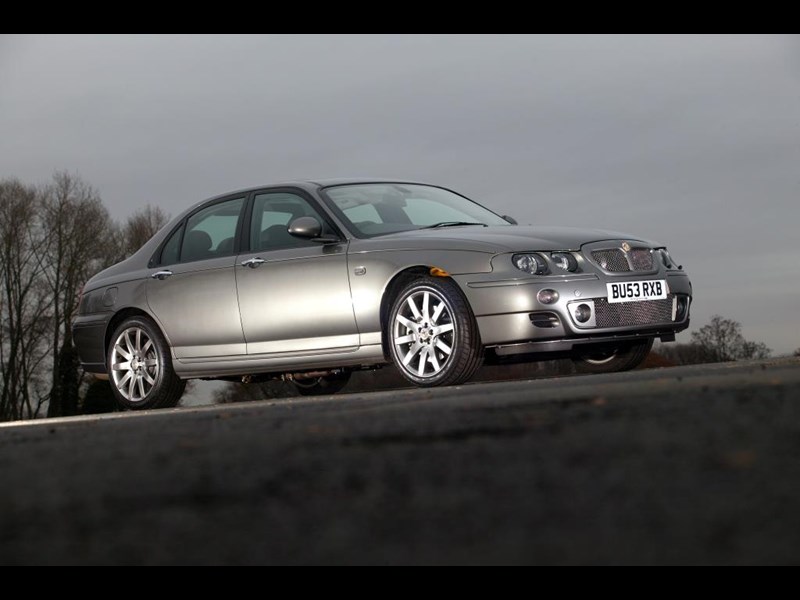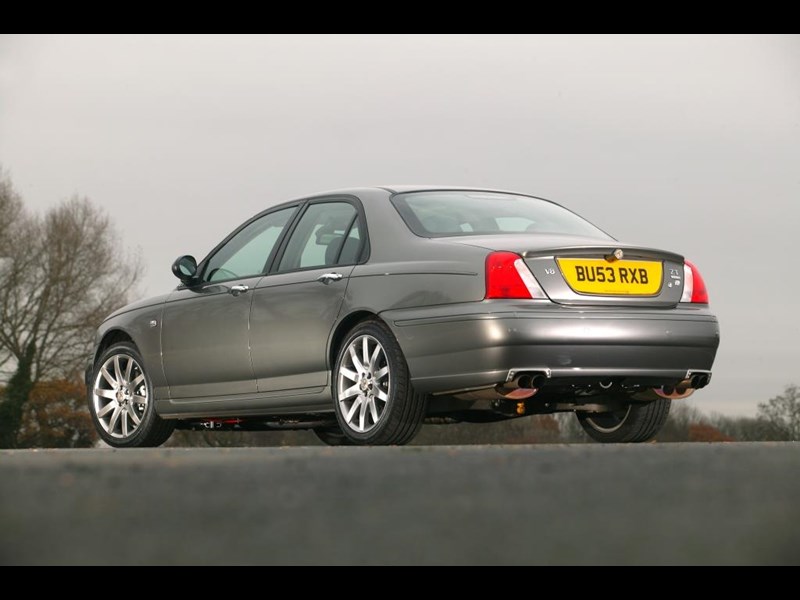WHAT TO LOOK FOR
BODY & CHASSIS
Poor repairs are common because the P5’s structure is large and complex. But it it’s also strong, so serious structural corrosion is rare. These cars have a basic monocoque onto which the outer panels bolt, making it easy to disguise an unsound car with fresh panels. Check the three-piece sills as they’re crucial to the car’s strength, but are prone to rot. Rotten original sills are less of a concern than badly repaired ones. Uneven panel gaps result from new panels being welded into place when the bodyshell is twisted.
Check the A-posts, outer rear wheelarches and base of each D-post. The outer panels are reasonably durable, but significant corrosion in the latter area requires removal of the rear wing, which is where costs quickly mount.The chassis legs can rot, especially around the leaf-spring mountings, as can the rear inner wings. Poking around behind the boot trim will give you a good idea of the state of the metal below. While you’re at it, examine all the metalwork at the back of the car, paying most attention to the valance.
Corrosion in the nose of the car won’t affect its structural integrity, but not so for rot at the back of the front wheelarches. At this point, the bulkhead, sill and door post meet; there’s also a cavity where mud collects before corroding the metal. Add to this a multitude of drain holes, box sections and cavities, all of which can corrode badly, and there’s the potential for major expenditure. If left unchecked, such corrosion can spread into the bulkhead; at this point the car is fit for parts only, but it may be passed off as one that merely needs minor attention.
The front subframe is unlikely to give problems, but it’s worth checking for corrosion around the torsion bar mounts anyway. Repairs are easy enough, but only once the subframe has been removed.
Door bottoms also warrant close inspection; it’s usually easier and cheaper to fit decent used panels if the originals are shot. The original hinges must be retained though, as they were fettled to attain correct panel gaps.
If you’re looking for a classic from which you can really get some use, a P5 makes a lot of sense. Where most people assume a classic will only be for occasional use, the P5 isn’t like that. Stylish and well-engineered, it’s so capable that it can be considered as an alternative to a modern, thanks to its refinement, pace and build-quality.
ENGINE
The 3-Litre’s powerplant was a bored-out version of the P4’s 2.6-litre unit, and like a well-maintained V8, it should be good for at least 200,000 miles between rebuilds. A neglected six-cylinder engine wears prematurely, with cylinder and valve guide wear in evidence.
A neglected six-cylinder engine wears prematurely, with cylinder and valve guide wear in evidence. That means oil being burned when the engine is started, and under acceleration – so look for blue smoke from the exhaust. Cam followers also get vocal once the mileage is high; the top end noise will be obvious but it’s easy and cheap to put right. It’s the same for the whole engine, which is straightforward and relatively cheap to rebuild; if in doubt, a decent used unit can be sourced for £250 from a specialist such as David Green.
The six-cylinder engine is known for its smoothness and abundance of torque. Don’t be alarmed if the oil pressure warning light flickers at idle – they all do that. It’s also quite common for there to be some blue smoke from the exhaust, while a pint of oil may be needed every 200- 300 miles without cause for concern. Make sure the engine mixture isn’t set too lean, as this can harm fuel consumption and cause a valve to burn out – uneven idling could point to this already having happened.
Like the six-pot motor, the Buick-sourced V8 is a hardy old lump, but runs at a much lower oil pressure than most of us will be used to – once again, an oil light that flickers on and off isn’t necessarily a cause for alarm. Find out whether good quality oil has been used regularly, otherwise the hydraulic tappets won’t operate correctly and the camshaft will also wear down its lobes prematurely.
It’s important the engine breathers on the rocker boxes have been kept clean, otherwise oil leaks will spring forth. Ascertain when the head gasket was changed, as its imperative a high-quality replacement has been used. On each head, some experts only tighten the outer four cylinderhead bolts to half the recommended torque, using thread-locking compound to keep them in place – this prevents the heads from tipping on the block. The tightness of the exhaust manifold nuts need checking, as they can work loose and leak, producing a tell-tale ticking. Don’t be surprised if the automatic choke doesn’t work – manual conversions or electrical over-rides are common. All P5Bs and some P5s were fitted with power steering, so make sure it’s working.
As with any alloy engine, it’s essential that a decent quality anti-freeze is used, and that it’s kept up to strength. Check that the engine doesn’t overheat when left idling – if it does, it may be because the radiator has got partially blocked by debris; a caring owner will have fitted a Kenlowe fan.
TRANSMISSION
The 3-Litre’s manual gearbox was carried over from the P4, and aside from worn synchromesh or bearings, there’s little to worry about. The former is given away by crunchy gear changes while the latter is betrayed by rumbling under load. Apart from a few early cars, all manual P5s have overdrive – make sure it cuts in smoothly as soon as it’s engaged.
All 3.5-litre cars have an automatic gearbox, but many 3-Litres have a stick-shift. Self-shifters featured a Borg Warner Type DG until 1965; later cars had a Type 35 unit. Despite the fact that the Type 35 can only just cope with the V8’s torque, there’s little to worry about. However, you must still ensure it swaps ratios smoothly and cleanly; as long as the transmission fluid has been changed periodically, all will be fine. It’s worth pulling out the dipstick to check the smell and colour of the fluid; it’s located at the rear of the engine, on the offside. Ensure the engine is running and warm; if the fluid smells of rotten eggs and is dark, it’s overheated and a rebuilt gearbox will be needed shortly, at £822 for an exchange unit.
Clutches and driveshafts are strong, but differentials leak and can run low on oil if left unchecked, but it’s unlikely to lead to a rebuild being needed. More likely is wear of the propshaft’s centre bearing (£20) or bushes (£25 per set) which wear, leading to vibration.
STEERING & SUSPENSION
All Coupés have power steering, but until late 1964 it was optional for the saloon. Set off in a P5B and you might think the tiller has been disconnected from the road wheels, the steering is so light – the system was never recalibrated for these later cars,. You get used to the lightness, but it’s initially disconcerting.
The assisted steering system tends to leak; the seals can weep and some castings are porous. The steering shouldn’t be left on full lock for more than 30 seconds at a time, to keep internal pressures down; ignoring this advice can lead to seals letting go. The best solution is a modified steering box, with better seals, available from JR Wadhams for £360.
While the P5’s rear suspension is conventional, the independent front set-up is unusual with its torsion bars. Problems are unlikely, except for sagging through old age. Any P5 with a droopy rear needs fresh leaf springs; if the gaiters have split, there may also be excessive wear of the leaves. Heavy duty replacement springs are £174 apiece.
More important than flat leaf springs are perished bushes for their rear mountings. They’re V-shaped and prone to disintegration; once this has taken place, you’ll see and feel the effects, which is why rapid replacement is essential.
The P5’s weight takes its toll on the shock absorbers, so do a bounce test at each corner to see how quickly the car settles; new dampers cost £60-70 apiece. Whether or not they need renewing, the front suspension bushes may be tired. Look for perishing of the rubber and feel for play in the damper mountings; if new bushes are required, they’re reasonably easy to fit and cost £67 for a full set.
WHEELS & BRAKES
All P5s came with pressed-steel wheels, which in the case of later models were of a Rostyle design. These can corrode all too readily – they’re finished in chrome-plated mild steel. Reviving them is tricky and a really good car can be let down by tatty wheels. Not many surviving wheels are in really good nick; if you can find a mint set you can pay up to £800 for all four.
The P5 is also one of those classics that owners never feel the need to fit alloys to, so there are no worries about clearance issues or having the wrong PCD.
The same goes for the braking system, which is utterly conventional. It’s a disc/drum set-up apart from the first year of production, which featured drums all round.
INTERIOR
That interior is fabulous when pristine, but can prove costly to revive if tatty. All the Wilton, wood and leather could cost up to £5,000 to revive professionally, so check everything closely for damage. Although the wood cappings are solid, the dash is veneered; the main dash is usually resilient, but the corners can delaminate because of water leaks.
If there’s any evidence that either of the windscreen seals need replacing, tread carefully. It’s a pig of a job, even for someone who knows what they’re doing – which is why you must ascertain who did the job if it’s already been done. Cars that haven’t been garaged may be suffering from leaks, so look for evidence of water ingress into the cabin, such as rotten carpeting or discoloured wood trim.
OUR VERDICT
Amazingly comfortable and easily capable of keeping up with modern traffic, the P5 offers ample space for a family and their luggage. Fuel consumption can be an issue, especially on P5Bs, so high-mileage drivers will need to beware. But parts are cheap, maintenance is easy and these cars are inherently tough and reliable.
If it was good enough for cabinet ministers, the P5 should be good enough for you. The age-old problem rears its ugly head once more though; where do you find a good one? If you’re aiming to keep the car for the long term, it’s probably worth paying a little over the odds to secure a minter or getting a car professionally restored; these cars may be undervalued, but you’ll ultimately get your money back unless you pay stupid sums.
You also need to work out which version you want. The obvious answer is a P5B Coupé; that’s what everyone is after. However, while this is the fastest and most stylish of the breed, V8 cars came only with an automatic gearbox, while the Coupé has a roof-line that’s two inches lower than the saloon. As a result, the back seat had to be lowered, so those in the back might feel claustrophobic on a long journey. Whatever you buy it’ll be surprisingly usable; it’s so well engineered, and hence so capable, that it’s a genuine alternative to a modern, thanks to its refinement, pace and build quality.

































